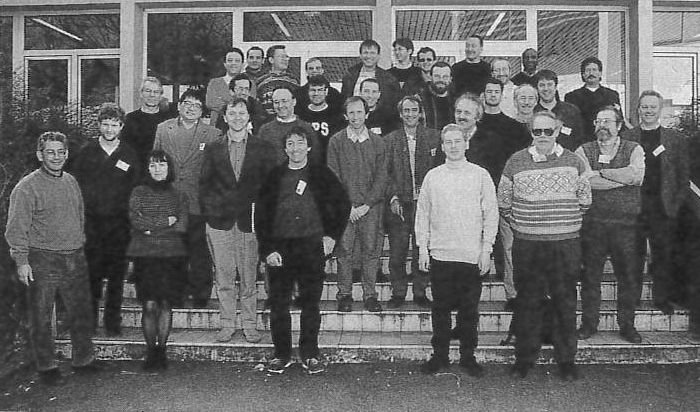


Meeting report
The canSAS Workshop
(or how one user's careless remarks can cause a lot of work)
 Participants at the canSAS Workshop.
Participants at the canSAS Workshop.
Representatives from major Small Angle X-Ray Scattering (SAXS) or Small Angle Neutron Scattering (SANS) facilities in the US, Europe and Japan met at Grenoble, Feb. 4-6, for the jointly organized (ILL/ESRF/DUBBLE) workshop on Collective Aid for Nomadic Small Angle Scatterers. The meeting addressed problems that users experience due to differences in the data formats and data analysis software at different facilities. At present each site has its own format and analysis programs.
Software developers (O. Glatter, Graz; D. Svergun and N. Stribeck, Hamburg and the CCP13 consortium), representatives from the NeXus and CIF data-format projects and a representative of the IUCr-SAS committee also attended.
Talks and demonstrations were combined with hands-on sessions to demonstrate programs and assess the principal problem areas. Aspects of SAXS and SANS research discussed included: data production, reduction, software requirements, format, scientific analysis and comparison with models.
P. Klosowski (NIST) described advantages of the NeXus file format. A. Hammersley (ESRF) highlighted a format (imageCIF) under development suited to large 2D image-plate datasets. R. Ghosh (ILL) and R. Hjelm (Los Alamos) stressed the importance of systematic storing of experimental parameters. The number of parameters that should be stored in Neutron Time-of-Flight data sets was shown to be considerably greater than with more conventional SANS or SAXS instruments. M. Capel (BNL) showed an impressive software suite for data analysis and primary data reduction.
Alternative proposals for data formats were discussed for time-resolved and large multi-dimensional datasets. NeXus was seen to provide a comprehensive description of raw data and its layout, and experimental configurations. ImageCIF has particular merits for archiving data related to crystallographic structures.
The working party identified the following priorities:
1. A web repository should be established containing an inventory of existing data formats.
2. Translation tools should be developed to which scientists can adapt their own routines.
3. A dictionary of terms to describe parameters and data in files should be created.
4. A standard ASCII data format for 1-D reduced data should be defined. Compatibility with spreadsheet analysis is considered important, as is the need to include parameter names and units.
5. A compilation of available data analysis software and program manuals is desirable and should be prepared.
A volunteer was identified to coordinate each of these activities. Therefore this will be organized as a workshop associated with the XI SAS conference in Brookhaven, May 1999.
Claudio Ferrero

